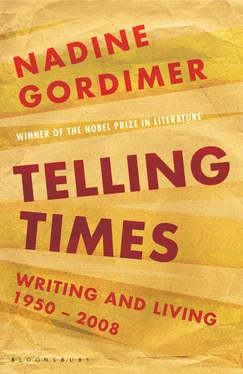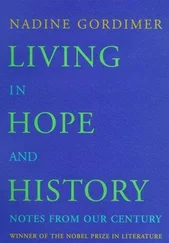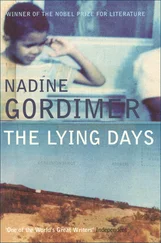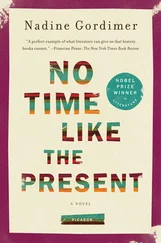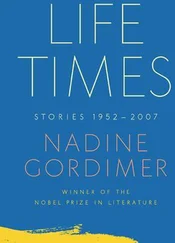By the time my sister and I were in our middle teens, we had lost our taste for solitude and the gentle wilderness. Our childhood love of Durban returned — for different reasons, of course — and I think that then we came to love the place for what it really is: in many ways a fascinating city, even if rather dull and smug intellectually. One of our chief delights at this time was our discovery of the Indian quarter of the town, and the Indian market. We enjoyed turning away from the pseudo-American and neo-Tudor architecture of the shopping centre and wandering down wide Grey Street, where the shops were small and crowded together and the balconies picked out in gaudy curlicues, and here and there a silver minaret or cupola shone. Among the more conventional stores, which sold men’s outfitting in fierce competition, were shops full of gauzy, tinselled lengths for saris, and Indian jewellers whose crammed windows seemed almost to tinkle with rows and rows of long gold earrings, and pendants strung upon thread. Those shops that were especially designed to entice European visitors like ourselves burned incense. Their dry, sweet odour was pleasant after the hot street, where splashes of chewed betel nut looked like blood on the pavement. In the Indian market there were piles of sweetmeats coloured violent pink and putrescent yellow, which smelled as revolting as they looked. We would return from these small expeditions with a particular type of sandal, thonged over the big toe, or a pair of earrings that looked as if they had been stamped out of thin gold tinfoil and that hung from the lobe to the shoulder. The sandals were called, if I remember rightly, chappals , and I know they were imported from India, but I do not remember ever seeing an Indian woman in Durban wear them. The earrings, without the folds of a sari to back them up, looked cheap and foolish in Western ears.
Like most South Africans, once I had been to Cape Town I wondered how I had ever thought Durban beautiful. Before I was quite grown up, I went alone with my father to Cape Town and we took a cable car to the top of Table Mountain. We stood there, on a clear, calm, perfect day, and, truly, for a little girl, that was god’s-eye look at the world. On such a day, you can see the whole Cape Peninsula, from Fishhoek on the one side, right around the ribs of mountain rising out of the sea, to Camps Bay on the other side. Some people even claim that you are looking at two oceans — the Atlantic on one side and the Indian on the other. But that is in dispute, for it is difficult to say where one ocean begins and the other ends. Anyway, the vast waters that lie before you are enough for two oceans. No peacock’s tail ever showed such blues and greens as the seas do from that height; all the gradations of depth are miraculously revealed, and, looking far, far down, where the colour crinkles and breaks into white near the shore, you see pale translucent areas in which the rocks show as boldly as if you were looking through the glass bottom of a boat directly above them.
It is something splendid, an almost superhuman experience, to see the tip of a continent, alive, at your feet. I know that I stumbled back to the cable station that day smiling constantly at my father but with the feeling of tears behind my eyes, in a confused state of exaltation that made it impossible for me to speak, and because I was so young, I immediately lost my exaltation in anger when I saw that many people who had come up with us on the cable car had been spending their half hour before the cable took us all down again writing postcards that would bear the postmark ‘Table Mountain’. These absorbed visitors scarcely glanced out of the windows at what they had come to see.
For some reason, our family did not visit the Kruger National Park until I was sixteen and in my last year at high school. Just how unusual this abstinence is, is difficult to explain to anyone who is not South African. For whatever else the South African in general, and the Transvaaler in particular, may or may not do for his family, he will manage somehow to get them to Kruger Park, the great wildlife preserve in the Transvaal. If he has no car, he will borrow one, and if he cannot do this, he will persuade a friend that two families can travel as uncomfortably as one, and beg a lift. The Park opens at the beginning of winter, in late April or early May, and by dawn on the opening day, cars and trucks loaded with camping equipment and tinned food are lined up in mile-long queues outside the various camps that serve as points of entry to the preserve.
I had heard so many tales and seen so many home movies about the Kruger Park (‘My dear, and then the lioness walked right up to the car and sniffed the tyres!’) that I almost dreaded going. I regarded listlessly the prospect of overcrowded camps, boerewors (a coarse, highly seasoned sausage held in sentimental regard by both Afrikaans- and English-speaking South Africans) cooked over an open fire, and long processions of cars crawling along the dusty roads in the stern rivalry of who would sight the most lions soonest. But when we went, it was very different from that. We went in October, during the last few days before the park closes for the summer rains and the calm that is granted the beasts for their breeding season. We stayed at a camp with a beautiful name — Shingwedsi — and we had the shade of its trees and the red blossoms of the cacti almost to ourselves. The peace of the bushveld was scarcely disturbed by the few cars on the roads.
The rainy season was a month off, but the first night we were at Shingwedsi the fantastic roar of a freak storm woke us at midnight and flooded the camp, marooning us for nearly twenty-four hours. During the next day, while we were shut in by drumming rain, my Uncle Robert, our mother’s younger brother, drank beer with and received the confidences of an engineer who lived and worked in the Park all the year round, watching over the boreholes that guarantee the animals’ water supply. At that period, I had just begun to read Hemingway, and it seemed to me that for the first time in my life something in fact had measured up to fiction. The engineer was just such a man as poor Francis Macomber might have chosen as an escort on a hunting trip. (And, on reflection, just such a man as Mrs Macomber might have wished him to choose.) He had a taciturn, world-weary air, and, in the cosy confinement of the rain, over the beer, he made Robert (since he was only ten years older than I, we girls did not call Robert ‘uncle’) feel that he, Robert, was the first person in years to whom he had been able to talk as he was talking, the first man whose sporting sense and sensitivity matched the engineer’s own, a man — at last! at last! — who instinctively would understand the boredom and tameness, for a man of spirit, of life in a sanctuary, with no one to talk to but gaping tourists. In fact, the engineer was one of those people who make others feel chosen. At five in the afternoon, when the rain had stopped, he stood up, flexed his tanned, muscular knees, and said, with a kind of stern, sardonic glee, ‘This is the time for elephant, if you want elephant. This water’ll keep the wardens out of my way for a day or so.’
Robert and I were agog, as we were meant to be. While Robert questioned him, unconsciously adopting the engineer’s terse manner as he tried to show that he ‘belonged’, I kept close by his side, determined not to be left out of this. The way to see elephants, to get right up close to them and just about feel them breathe on you as you photographed them, said the engineer, was to take a light truck and go after them fast, ignoring the strict twenty-five-mile-an-hour speed limit in force in the preserve, and then, when you sighted them, to get out and stalk them on foot, ignoring the still stricter rule that no visitor may leave his car. Robert and I grinned with excitement. ‘But you can only do it when those bastards are sitting with their feet in mustard water,’ said the engineer, referring to the wardens. Well, that was now.
Читать дальше
